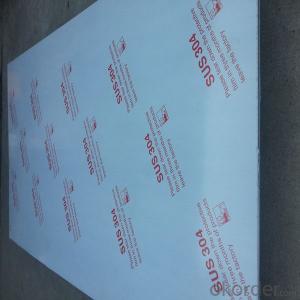Stainless Steel Sheet TP201 2mm Thickness
- Loading Port:
- Shanghai
- Payment Terms:
- TT OR LC
- Min Order Qty:
- 3 m.t.
- Supply Capability:
- 30000 m.t./month
OKorder Service Pledge
OKorder Financial Service
You Might Also Like
Item specifice
High quality stainless steel sheet tp 201
1.Length:1000-6000mm
2.Width ;600-2500mm
3.Thicknes:0.3mm-150mm
Brand: | ISCO, LISCO, ZPSS, Baoxin |
Certification: | ISO DNV etc |
Surface: | No.1 No.4 BA 2B HL 8K or as requested |
Manufacture: | Hot rolled/cold rolled |
Standard: | JIS, AISI, ASTM, GB, DIN, etc. |
Delivery time: | Within 7-10 working days since get the deposit |
Quality: | Prime quality |
Package: | Standard sea-worthy packaging(cover with PVC and wooden case), or as buyers' requirement |
Weight of coil | 5~6 tons |
Payment terms | 30% as deposit by T/T , and the balance should be paid by T/T against copy of B/L or L/C. |
Productive: | 5000 tons per week |
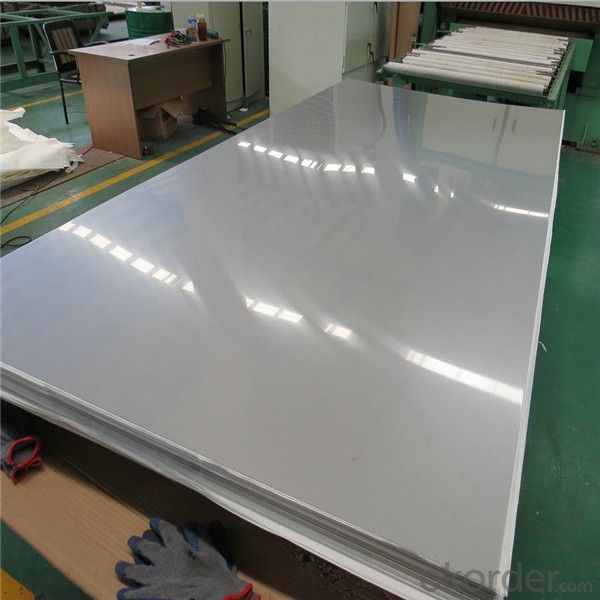
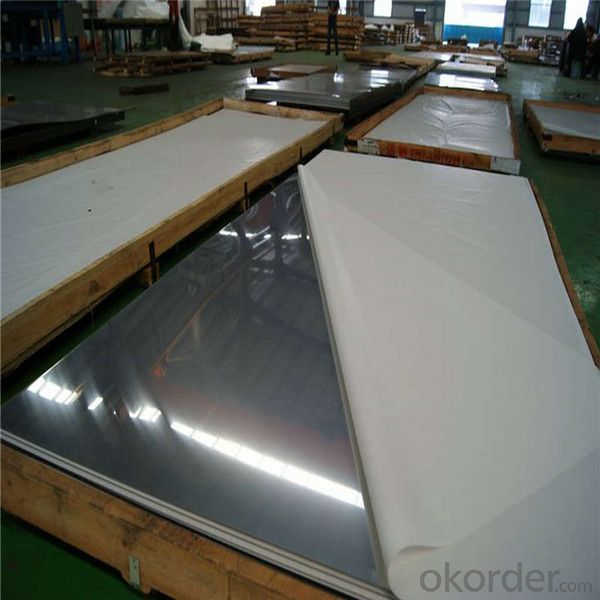
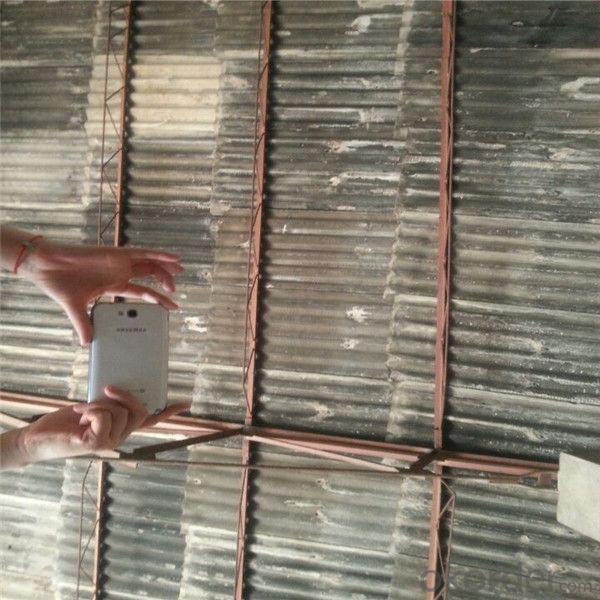
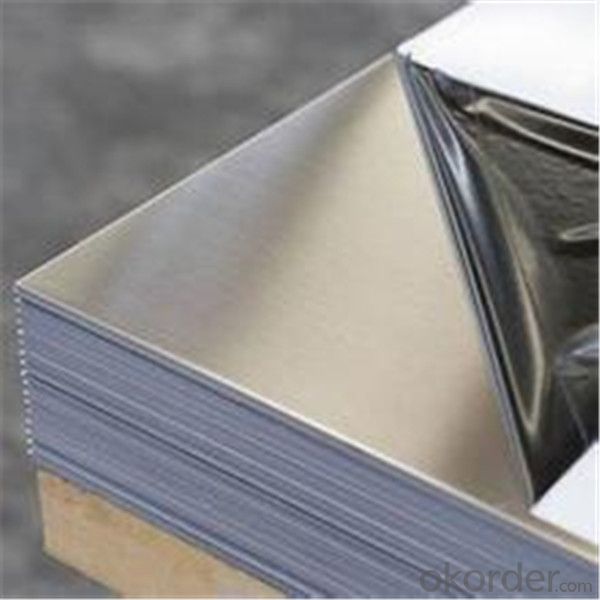
- Q:Can stainless steel sheets be cold rolled?
- Indeed, it is possible to cold roll stainless steel sheets. The cold rolling process involves passing a stainless steel sheet through a sequence of rollers at ambient temperature, leading to a decrease in thickness and an augmentation in both hardness and strength. By employing this technique, one can create stainless steel sheets with accurate measurements and impeccable surface textures. Cold rolling is widely utilized in the production of stainless steel sheets, catering to diverse sectors including automotive parts, kitchen devices, and architectural constructions.
- Q:Can stainless steel sheets be used for elevator mirrors?
- Certainly! Elevator mirrors can indeed be made using stainless steel sheets. Stainless steel, being both durable and versatile, is a favored material for elevator interiors due to its sleek and polished look. By polishing stainless steel sheets to a mirror-like finish, they can be effectively utilized as reflective surfaces for elevator mirrors. Furthermore, stainless steel's resistance to corrosion makes it well-suited for the humid and frequently challenging conditions typically encountered in elevators.
- Q:Are stainless steel sheets resistant to impact?
- Stainless steel sheets possess a general resistance to impact. Renowned for their robustness and durability, stainless steel is capable of enduring substantial force without deformation or fracture. This quality renders stainless steel sheets highly sought after in the construction, automotive, and aerospace sectors, where impact resistance is imperative. Moreover, the impact resistance of stainless steel sheets can be augmented by subjecting them to additional hardening or tempering processes, tailored to meet the precise demands of the application at hand.
- Q:How do stainless steel sheets differ from regular steel sheets?
- Stainless steel sheets differ from regular steel sheets in several key aspects. Firstly, stainless steel is an alloy that contains a minimum of 10.5% chromium by mass. This chromium content forms a protective passive layer on the surface of the steel, which helps to prevent corrosion and staining. In contrast, regular steel sheets are prone to rusting and corrosion when exposed to moisture or certain chemicals. Secondly, stainless steel sheets have a higher resistance to heat and oxidation compared to regular steel sheets. This makes stainless steel an ideal choice for applications that require high temperature resistance, such as industrial furnaces or automotive exhaust systems. Thirdly, stainless steel sheets possess excellent strength and durability, making them suitable for various structural and industrial applications. Regular steel sheets may have lower strength and durability, depending on their composition and manufacturing process. Additionally, stainless steel sheets have an attractive appearance due to their smooth and shiny surface. This aesthetic quality makes stainless steel sheets a popular choice in architectural, interior design, and decorative applications. Lastly, stainless steel sheets are known for their hygienic properties, as they are non-porous and easy to clean. This makes them commonly used in industries with strict hygiene requirements, such as food processing, pharmaceuticals, and healthcare. Overall, the major differences between stainless steel sheets and regular steel sheets lie in their corrosion resistance, heat resistance, strength, appearance, and hygiene properties. These unique characteristics make stainless steel sheets a preferred material for many industries and applications.
- Q:What are the different types of punched finishes available for stainless steel sheets?
- There are several different types of punched finishes available for stainless steel sheets, each offering unique characteristics and benefits. Some of the most common punched finishes include: 1. Round Hole: This is the most basic and widely used punched finish. It features evenly spaced round holes that provide good airflow and visibility. It is commonly used in applications such as ventilation systems, decorative panels, and filters. 2. Square Hole: Similar to round hole punched finish, square hole punched finish offers a clean and modern look. It is often preferred when a more geometric pattern is desired. Square hole punched sheets are commonly used in architectural applications, screens, and fencing. 3. Slotted Hole: Slotted hole punched finish is characterized by elongated holes that provide larger openings for increased visibility or improved drainage. It is commonly used in applications such as grilles, sunshades, and safety barriers. 4. Hexagonal Hole: Hexagonal hole punched finish features hexagon-shaped holes that offer a unique and aesthetically pleasing pattern. It is commonly used in decorative applications, such as wall cladding, signage, and artistic installations. 5. Decorative Patterns: In addition to the standard punched finishes, there are various decorative patterns available for stainless steel sheets. These patterns can include custom designs, logos, or intricate shapes, adding a personalized touch to any project. The choice of punched finish depends on the specific requirements of the application, including aesthetics, functionality, and performance. It is important to consider factors such as hole size, open area percentage, strength, and corrosion resistance when selecting the appropriate punched finish for stainless steel sheets.
- Q:What are the common uses of stainless steel sheets in the food industry?
- Stainless steel sheets are commonly used in the food industry for various purposes such as food processing equipment, countertops, sinks, storage tanks, and machinery. The material's corrosion resistance, durability, and ease of cleaning make it ideal for maintaining hygienic conditions and preventing contamination in food preparation and storage areas.
- Q:What are the different methods of cutting stainless steel sheets?
- There are several methods available for cutting stainless steel sheets, depending on the specific requirements and desired precision. 1. Shearing: This is one of the most common methods used for cutting stainless steel sheets. It involves using a shearing machine with sharp blades to cut through the material. Shearing is ideal for straight cuts and is relatively fast and cost-effective. 2. Laser cutting: Laser cutting is a highly precise method that uses a high-powered laser beam to cut through stainless steel sheets. It provides a clean and smooth cut, and can be used to create intricate designs or complex shapes. Laser cutting is widely used in industries that require high precision and quality finishes. 3. Plasma cutting: Plasma cutting uses a high-temperature plasma arc to melt through stainless steel sheets. This method is suitable for cutting thick stainless steel sheets or materials with high conductivity. Plasma cutting offers fast cutting speeds and can handle various shapes and thicknesses. 4. Waterjet cutting: Waterjet cutting involves using a high-pressure jet of water mixed with abrasive particles to cut through stainless steel sheets. This method is highly versatile and can create complex shapes with high precision. Waterjet cutting is also a cold cutting process, which means it does not produce heat-affected zones or alter the material's structure. 5. Abrasive cutting: This method uses an abrasive wheel or disc to grind and cut through stainless steel sheets. It is commonly used for rough cuts or in situations where other methods are not feasible. Abrasive cutting can be done manually or with the help of power tools, such as angle grinders. Each of these cutting methods has its own advantages and limitations, and the choice of method depends on factors such as the thickness of the stainless steel sheet, desired precision, budget, and production requirements.
- Q:Are stainless steel sheets suitable for railway station platforms?
- Yes, stainless steel sheets are suitable for railway station platforms. They are durable, resistant to corrosion, and can withstand heavy foot traffic, making them ideal for this application. Additionally, stainless steel sheets are easy to clean and maintain, ensuring a safe and aesthetically pleasing platform for passengers.
- Q:How do you prevent staining or discoloration on stainless steel sheets in coastal environments?
- Preventing staining or discoloration on stainless steel sheets in coastal environments necessitates a combination of regular maintenance and protective measures. Here are several effective approaches to avoid such problems: 1. Routine cleaning: Employ mild soap or detergent and warm water to regularly clean the stainless steel sheets. Gently wipe the surface with a soft cloth or sponge to eliminate salt, dirt, or grime that may lead to staining. 2. Avoid abrasive cleaners: Refrain from using abrasive cleaners, steel wool, or harsh chemicals on stainless steel sheets as they can scratch or harm the surface, rendering it more vulnerable to staining. 3. Rinse with fresh water: After cleaning, thoroughly rinse the stainless steel sheets with fresh water to eradicate any lingering cleaning agents or salt deposits that could cause discoloration. 4. Apply protective coatings: You can apply protective coatings specifically formulated for stainless steel to establish a barrier against saltwater and other corrosive elements. These coatings can effectively prevent staining and discoloration by providing a protective layer on the surface. 5. Utilize stainless steel cleaners: Regularly utilize stainless steel cleaners or polishes to preserve the appearance and safeguard the surface of the stainless steel sheets. These products can assist in removing any surface stains or discoloration and leave behind a protective layer. 6. Ensure proper ventilation: Ensure proper ventilation in the vicinity where the stainless steel sheets are installed. Adequate airflow can aid in minimizing moisture and salt accumulation in the environment, thereby reducing the likelihood of staining or discoloration. 7. Conduct regular inspections: Routinely inspect the stainless steel sheets for any indications of staining or discoloration. Early detection can help promptly address any issues and prevent further damage. By implementing these preventive measures and incorporating regular maintenance, you can significantly diminish the risk of staining or discoloration on stainless steel sheets in coastal environments, ensuring their longevity and aesthetic appeal.
- Q:Are stainless steel sheets suitable for water treatment applications?
- Water treatment applications can greatly benefit from the use of stainless steel sheets. The reason for this is that stainless steel has exceptional resistance to corrosion, making it the perfect material for environments where there is a presence of water and moisture. It is able to withstand rust, staining, and pitting, guaranteeing the sheets' longevity and durability in water treatment facilities. Moreover, stainless steel sheets possess hygienic qualities. They are effortless to clean and maintain, which is especially crucial in water treatment applications where cleanliness and sanitation are of the utmost importance. Additionally, stainless steel does not react with water, meaning it does not release harmful substances into the water being treated. In addition to these benefits, stainless steel sheets exhibit strength and can tolerate high pressures and temperatures. This is highly significant in water treatment processes that involve filtration, disinfection, and other treatment methods that may require rigorous conditions. To conclude, stainless steel sheets are an outstanding option for water treatment applications due to their resistance to corrosion, hygienic properties, strength, and durability. They present a dependable and long-lasting solution for various components in water treatment facilities, including tanks, pipes, valves, and other equipment.
1. Manufacturer Overview |
|
|---|---|
| Location | |
| Year Established | |
| Annual Output Value | |
| Main Markets | |
| Company Certifications | |
2. Manufacturer Certificates |
|
|---|---|
| a) Certification Name | |
| Range | |
| Reference | |
| Validity Period | |
3. Manufacturer Capability |
|
|---|---|
| a)Trade Capacity | |
| Nearest Port | |
| Export Percentage | |
| No.of Employees in Trade Department | |
| Language Spoken: | |
| b)Factory Information | |
| Factory Size: | |
| No. of Production Lines | |
| Contract Manufacturing | |
| Product Price Range | |
Send your message to us
Stainless Steel Sheet TP201 2mm Thickness
- Loading Port:
- Shanghai
- Payment Terms:
- TT OR LC
- Min Order Qty:
- 3 m.t.
- Supply Capability:
- 30000 m.t./month
OKorder Service Pledge
OKorder Financial Service
Similar products
New products
Hot products
Related keywords
